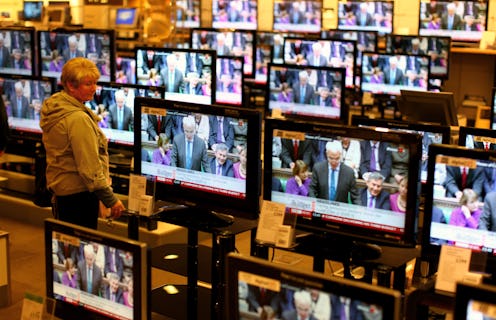According to a few studies released this week by the Gay and Lesbian Alliance Against Defamation (GLAAD), there is better LGBT representation on Internet and cable programs than broadcast networks which, like, duh. Mainstream television hasn't historically been the hub for progressiveness, and it's not uncommon for subgroups or marginalized people to use slightly less widely accessed mediums for artistic expression.
The results of this report are important for several reasons, but the primary reason we should care about LGBT+ representation anywhere in the media is that more often than not, television claims to change with the times and become better adapted to the ways in which culture shifts. If we leave LGBT people and their stories out of that shift, there is an inaccurate reflection of the real world on TV, which is where all people, LGBT or not, look to find stories about themselves, their lives, their friends, and their experiences. Without an LGBT narrative in television, a large amount of people's lives are being erased.
Though there were many statistics regarding LGBT representation on television in these reports, the most basic one that is uses is a scale rating shows either "excellent," "good," "adequate," or "failing." Check out how your favorite channels rank below:
Excellent: ABC Family, HBO, MTV
Some LGBT inclusive shows on these networks (past and present) include: Pretty Little Liars, Faking It, Looking, The Fosters, The Secret Life of the American Teenager, Skins. MTV is doing especially well.
Good: ABC, the CW, FOX, NBC, FX, Showtime
Some LGBT inclusive shows on these networks (past and present) include: Modern Family, 90210, Glee, Bones, The L Word, Masters of Sex, The Carrie Diaries, American Horror Story.
Adequate: CBS, TLC, USA
Some LGBT inclusive shows on these networks (past and present) include: Under the Dome, Political Animals, Fairly Legal.
Failing: A&E, the History Channel, TNT
Some LGBT-inclusive shows on these networks (past and present) include: Southland.
The ratings are awarded based on quality, diversity, and quantity relative to other shows of LGBT content. This means that even if MTV's Faking It isn't the best depiction of LGBT people or culture, there is depiction, which is miles ahead of any sort of representation, whether it's positive or negative, on a network like the History Channel for example, where there are no LGBT shows or characters. The report, which is called "Where We Are on TV" doesn't only focus on LGBT sexuality but also intersections of sex, gender, race, ethnicity, class, and disability in the context of broadcast networks, cable networks, daytime television, Spanish language media, and daytime content. So it's pretty exhaustive in its approach, and the ratings come from a lot of different factors.
According to the report, there are some big things celebrate. LGBT representation on TV is up at least 3 percent from last year, with FOX in particular increasing it's diversity by 6.5 percent. But there are also plenty of things that need work, for example LGBT people of color only make up 27 percent of regular characters and people with disabilities only make up 1.7 percent. Percentage of female characters has declined from 43 percent to 40 percent and there are virtually no trans characters depicted anywhere. While some things are trending in a generally better direction, there's a lot of work to still be done.
Images: Giphy
